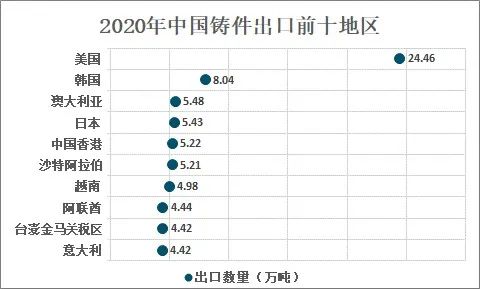Here comes a comprehensive analysis of global castings
Castings are metal moldings obtained by various casting methods, that is, the smelted liquid metal is poured into a pre-prepared mold by pouring, injection, suction or other casting methods, and after cooling, it is polished and other subsequent processing methods. The resulting object has a certain shape, size and performance.
According to data from the American Foundry Association: In 2019, the global casting output was 109 million tons, a year-on-year decrease of 3.2% from 113 million tons in 2018. China's casting output accounted for more than 40% of the world's total output, and it accounted for 44.7% in 2019, an increase of 0.9% from 2018.
The top ten regions for global casting production in 2019 are China, India, the United States, Japan, Germany, Russia, Mexico, South Korea, Turkey, and Brazil, with output of 48.75 million tons, 11.49 million tons, 11.31 million tons, 5.28 million tons, and 4.95 million tons respectively. 10,000 tons, 4.2 million tons, 2.86 million tons, 2.38 million tons, 2.31 million tons, and 2.29 million tons.
The development status of China's casting industry
1. Yield
In recent years, the rapid development of China's foundry technology has enabled China to gradually move from a major foundry country to a powerful foundry country. At the same time, various precision casting products have also been widely used in various fields, greatly promoting the progress and development of various fields, and the casting industry has become an important industry that promotes the development of my country's national economy. In 2020, China's casting output was 51.95 million tons, an increase of 6.6% from the 48.75 million tons in 2019.
Except for the decline in the output of aluminum (magnesium) alloy castings, the output of other material castings increased. The output of aluminum (magnesium) alloy castings was mainly due to factors such as the decline in passenger car output and the sharp decline in exports of aluminum wheels. In 2020, the output of gray cast iron castings will be 21.75 million tons, the output of ductile iron will be 15.3 million tons, and the output of aluminum (magnesium) alloy castings will be 6.8 million tons.
Judging from the distribution pattern of China's casting materials in 2020, gray cast iron accounted for 41.9%, ductile iron accounted for 29.5%, aluminum (magnesium) alloy accounted for 13.1%, cast steel accounted for 12.2%, and copper alloy accounted for 1.7%.
The automotive sector is still the largest application field of China's castings. In 2020, the demand for castings in the automotive sector will be 15 million tons; followed by the cast pipe and pipe fittings with a demand of 8.53 million tons; the demand for castings in the field of internal combustion engines and agricultural machinery is 5.4 million tons; The demand for castings in the construction machinery sector is 4.9 million tons.
From the perspective of the distribution pattern of China's downstream demand for castings in 2020, the automotive sector accounted for 28.9%, the cast pipe and pipe fittings sector accounted for 16.4%, the internal combustion engine and agricultural machinery sector accounted for 10.4%, and the construction machinery sector accounted for 9.4%.
2. Import and export trade
With the continuous efforts of Chinese foundry companies to improve product quality and technical content, China has gradually become one of the world’s largest exporters of castings. In 2020, China’s casting exports amounted to 1.649 million tons, a decrease of 30,600 tons from 2019; the number of imports was 17,600 Tons, a decrease of 3,900 tons compared with 2019.
In 2019, China's casting imports were US$139 million and exports were US$2.802 billion; in 2020, China's castings imports were US$132 million and exports were US$2.781 billion.
The average import price of castings in my country is relatively high, and the average export price is low. However, in recent years, the average export price of Chinese castings has been rising. In 2020, the average import price of Chinese castings is 7.52 US dollars/kg, and the average export price is 1.69 US dollars/kg. The difference is 5.83 US dollars/kg.
Chinese castings are mainly exported to the United States, South Korea, Australia and other places. In 2020, Chinese castings were exported to the US 244,600 tons, accounting for 14.8% of total exports; 80,400 tons to South Korea, accounting for 4.9% of total exports; exports to Australia 54,800 tons, accounting for 3.3% of the total export volume.


